Jiahuan Ren
GT-Rain Single Image Deraining Challenge Report
Mar 18, 2024


Abstract:This report reviews the results of the GT-Rain challenge on single image deraining at the UG2+ workshop at CVPR 2023. The aim of this competition is to study the rainy weather phenomenon in real world scenarios, provide a novel real world rainy image dataset, and to spark innovative ideas that will further the development of single image deraining methods on real images. Submissions were trained on the GT-Rain dataset and evaluated on an extension of the dataset consisting of 15 additional scenes. Scenes in GT-Rain are comprised of real rainy image and ground truth image captured moments after the rain had stopped. 275 participants were registered in the challenge and 55 competed in the final testing phase.
Clarity ChatGPT: An Interactive and Adaptive Processing System for Image Restoration and Enhancement
Nov 20, 2023


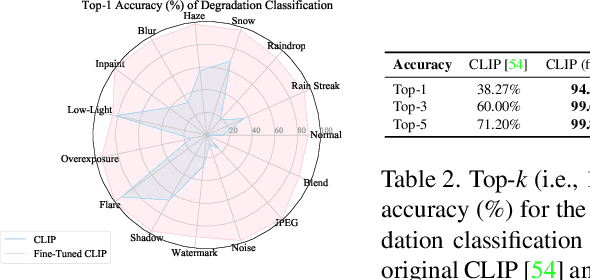
Abstract:The generalization capability of existing image restoration and enhancement (IRE) methods is constrained by the limited pre-trained datasets, making it difficult to handle agnostic inputs such as different degradation levels and scenarios beyond their design scopes. Moreover, they are not equipped with interactive mechanisms to consider user preferences or feedback, and their end-to-end settings cannot provide users with more choices. Faced with the above-mentioned IRE method's limited performance and insufficient interactivity, we try to solve it from the engineering and system framework levels. Specifically, we propose Clarity ChatGPT-a transformative system that combines the conversational intelligence of ChatGPT with multiple IRE methods. Clarity ChatGPT can automatically detect image degradation types and select appropriate IRE methods to restore images, or iteratively generate satisfactory results based on user feedback. Its innovative features include a CLIP-powered detector for accurate degradation classification, no-reference image quality evaluation for performance evaluation, region-specific processing for precise enhancements, and advanced fusion techniques for optimal restoration results. Clarity ChatGPT marks a significant advancement in integrating language and vision, enhancing image-text interactions, and providing a robust, high-performance IRE solution. Our case studies demonstrate that Clarity ChatGPT effectively improves the generalization and interaction capabilities in the IRE, and also fills the gap in the low-level domain of the existing vision-language model.
Seeing Through The Noisy Dark: Toward Real-world Low-Light Image Enhancement and Denoising
Oct 07, 2022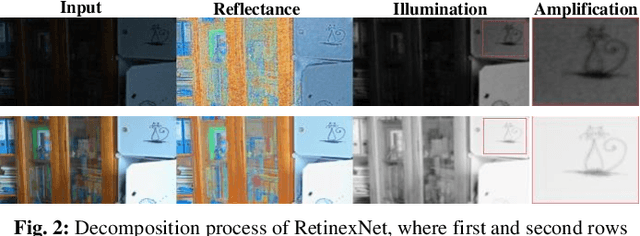

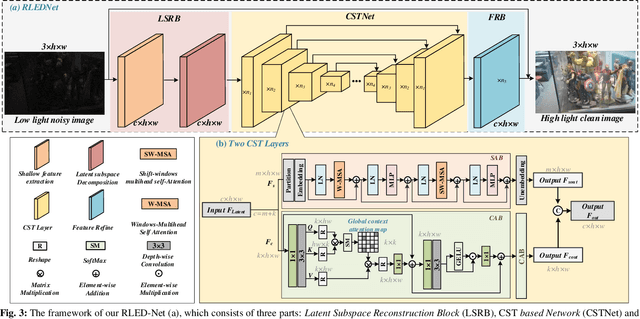
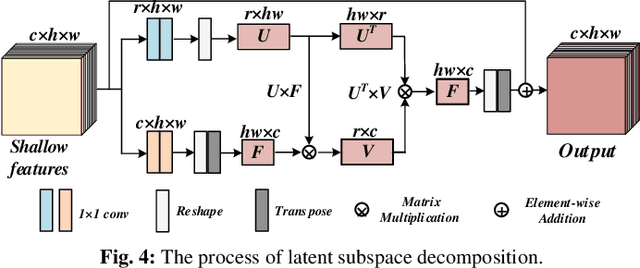
Abstract:Images collected in real-world low-light environment usually suffer from lower visibility and heavier noise, due to the insufficient light or hardware limitation. While existing low-light image enhancement (LLIE) methods basically ignored the noise interference and mainly focus on refining the illumination of the low-light images based on benchmarked noise-negligible datasets. Such operations will make them inept for the real-world LLIE (RLLIE) with heavy noise, and result in speckle noise and blur in the enhanced images. Although several LLIE methods considered the noise in low-light image, they are trained on the raw data and hence cannot be used for sRGB images, since the domains of data are different and lack of expertise or unknown protocols. In this paper, we clearly consider the task of seeing through the noisy dark in sRGB color space, and propose a novel end-to-end method termed Real-world Low-light Enhancement & Denoising Network (RLED-Net). Since natural images can usually be characterized by low-rank subspaces in which the redundant information and noise can be removed, we design a Latent Subspace Reconstruction Block (LSRB) for feature extraction and denoising. To reduce the loss of global feature (e.g., color/shape information) and extract more accurate local features (e.g., edge/texture information), we also present a basic layer with two branches, called Cross-channel & Shift-window Transformer (CST). Based on the CST, we further present a new backbone to design a U-structure Network (CSTNet) for deep feature recovery, and also design a Feature Refine Block (FRB) to refine the final features. Extensive experiments on real noisy images and public databases verified the effectiveness of our RLED-Net for both RLLIE and denoising.
Learning Hybrid Representation by Robust Dictionary Learning in Factorized Compressed Space
Dec 26, 2019



Abstract:In this paper, we investigate the robust dictionary learning (DL) to discover the hybrid salient low-rank and sparse representation in a factorized compressed space. A Joint Robust Factorization and Projective Dictionary Learning (J-RFDL) model is presented. The setting of J-RFDL aims at improving the data representations by enhancing the robustness to outliers and noise in data, encoding the reconstruction error more accurately and obtaining hybrid salient coefficients with accurate reconstruction ability. Specifically, J-RFDL performs the robust representation by DL in a factorized compressed space to eliminate the negative effects of noise and outliers on the results, which can also make the DL process efficient. To make the encoding process robust to noise in data, J-RFDL clearly uses sparse L2, 1-norm that can potentially minimize the factorization and reconstruction errors jointly by forcing rows of the reconstruction errors to be zeros. To deliver salient coefficients with good structures to reconstruct given data well, J-RFDL imposes the joint low-rank and sparse constraints on the embedded coefficients with a synthesis dictionary. Based on the hybrid salient coefficients, we also extend J-RFDL for the joint classification and propose a discriminative J-RFDL model, which can improve the discriminating abilities of learnt coeffi-cients by minimizing the classification error jointly. Extensive experiments on public datasets demonstrate that our formulations can deliver superior performance over other state-of-the-art methods.
Robust Subspace Discovery by Block-diagonal Adaptive Locality-constrained Representation
Aug 04, 2019



Abstract:We propose a novel and unsupervised representation learning model, i.e., Robust Block-Diagonal Adaptive Locality-constrained Latent Representation (rBDLR). rBDLR is able to recover multi-subspace structures and extract the adaptive locality-preserving salient features jointly. Leveraging on the Frobenius-norm based latent low-rank representation model, rBDLR jointly learns the coding coefficients and salient features, and improves the results by enhancing the robustness to outliers and errors in given data, preserving local information of salient features adaptively and ensuring the block-diagonal structures of the coefficients. To improve the robustness, we perform the latent representation and adaptive weighting in a recovered clean data space. To force the coefficients to be block-diagonal, we perform auto-weighting by minimizing the reconstruction error based on salient features, constrained using a block-diagonal regularizer. This ensures that a strict block-diagonal weight matrix can be obtained and salient features will possess the adaptive locality preserving ability. By minimizing the difference between the coefficient and weights matrices, we can obtain a block-diagonal coefficients matrix and it can also propagate and exchange useful information between salient features and coefficients. Extensive results demonstrate the superiority of rBDLR over other state-of-the-art methods.
Joint Subspace Recovery and Enhanced Locality Driven Robust Flexible Discriminative Dictionary Learning
Jun 11, 2019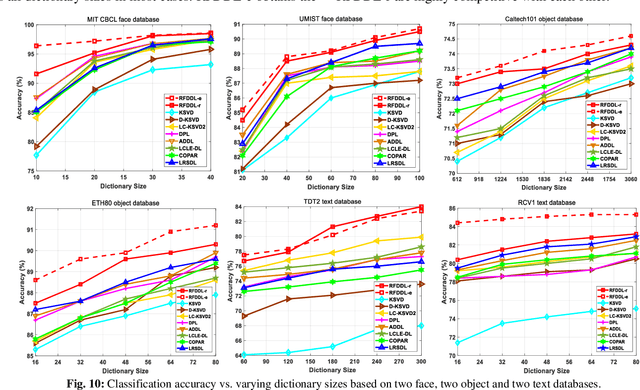

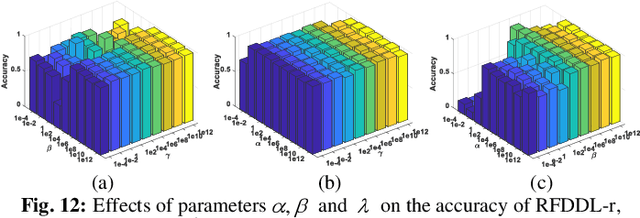

Abstract:We propose a joint subspace recovery and enhanced locality based robust flexible label consistent dictionary learning method called Robust Flexible Discriminative Dictionary Learning (RFDDL). RFDDL mainly improves the data representation and classification abilities by enhancing the robust property to sparse errors and encoding the locality, reconstruction error and label consistency more accurately. First, for the robustness to noise and sparse errors in data and atoms, RFDDL aims at recovering the underlying clean data and clean atom subspaces jointly, and then performs DL and encodes the locality in the recovered subspaces. Second, to enable the data sampled from a nonlinear manifold to be handled potentially and obtain the accurate reconstruction by avoiding the overfitting, RFDDL minimizes the reconstruction error in a flexible manner. Third, to encode the label consistency accurately, RFDDL involves a discriminative flexible sparse code error to encourage the coefficients to be soft. Fourth, to encode the locality well, RFDDL defines the Laplacian matrix over recovered atoms, includes label information of atoms in terms of intra-class compactness and inter-class separation, and associates with group sparse codes and classifier to obtain the accurate discriminative locality-constrained coefficients and classifier. Extensive results on public databases show the effectiveness of our RFDDL.
 Add to Chrome
Add to Chrome Add to Firefox
Add to Firefox Add to Edge
Add to Edge